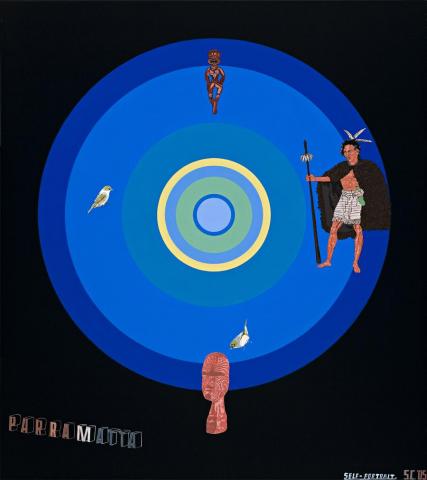SELF PORTRAIT, 2005
Shane Cotton
synthetic polymer paint on canvas
180.0 x 160.0 cm
signed and dated lower right: S.C.’05
inscribed lower right: SELF PORTRAIT.
Sherman Galleries, Sydney (stamped verso)
Private collection, Sydney
Shane Cotton, Pararaiha, Sherman Galleries, Sydney, 28 July – 20 August 2005
'Shane Cotton is a postmodern Maori 'merchant of ideas'. His art activates, intervenes upon and transforms traditional Maori narratives, stimulating and challenging Western explanations of Maori'.1
Shane Cotton is one of the leading contemporary Maori New Zealander artists of the moment. Described as a 'history painter', Cotton projects his identity into synthesis with a world view through paint, experimenting with cultural thinking. Cotton's paintings explore questions of colonialism, cultural identity, Maori spirituality and death.
Self Portrait was first exhibited in the 2005 exhibition 'Pararaiha' (meaning paradise) at Sherman Galleries, Sydney. This exhibition was characterised by canvases with blue moko mokai (preserved tattooed Maori heads), rocky arid landscapes with well-known landmarks, black backgrounds and targets. This body of work pre-empted much of the apocalyptic sentiment in Cotton's most current work.
In this work, there is a strong display of Cotton's characteristic reconstituting and mixing of icons, symbols and ideas to create a hybrid aesthetic. Here, Cotton plays with traditions of hard-edge abstraction as Maori figurative meets Pop and Op art with the inclusion of a slick airbrushed brightly coloured target. The central motif of the target is in a palette of gradations of blue, yellow and green. This target is presented as a segmented wedge with layers signifying the progression of history; a form of visual historical documentation. In this way, we can view Cotton as an informal history painter.
There is a stark dichotomy in how Cotton views himself, as both Maori, and as global citizen. This is a complex identity that continuously intertwines past and present. In this way, his work can be likened to the plight of many of his indigenous peers in forging a style that incorporates important cultural histories in a contemporary context.
The influence of Maori figurative imagery signals Cotton's ongoing auto-biographical project. This figurative style can be likened to the flat narrative-like representation of Musaviri painting that originates from Iran and Pakistan. In Self Portrait, we see a pan-tribal elder donning a cape with a feathered head piece, a tiki (now an over-used Maori tourist symbol), an ancient statue, and two birds, a hummingbird (native to North America, that symbolises hope), and a gold finch (a powerful symbol in Renaissance art, reflecting the Passion of Christ). There is also the employment of Maori text, utilised as a graphic appendage.
There is no strong attempt to create serious depth as these objects and figures float weightlessly close to the surface. These forms drift free from anchors of reference, drawing on an unknown sense of gravity into a new placement of context and chance encounter. Meaning is blended, isolated and suspended amid disparate pictorial elements. The effect is diagrammatic, yet also dreamlike.
Self Portrait is a culmination of many of Cotton's significant ideas regarding the understanding of self.
1. Ngahiraka Mason, 'The Maori Merchants of Nga Puhi', 2005, exhibition catalogue for Pararaiha, Sherman Galleries, Sydney
RACHAEL WATTS
